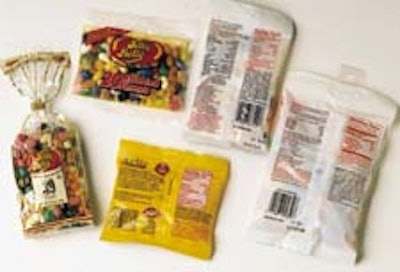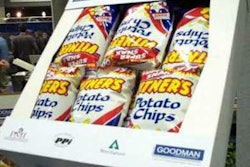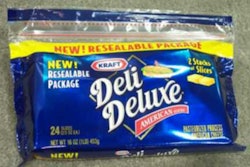The worst time to find out that the Universal Product Code (UPC) symbol on a product’s packaging will not scan is at the customer’s checkout or point-of-sale (POS). For that product to then be sold, the cashier must attempt a rescan, enter the UPC digits manually or stop the checkout process altogether to do a price check. These extra steps can be costly in many ways.
Retailers such as Walgreens, Costco, Kmart, Home Depot, Wal-Mart and Target rely on bar-code information to streamline operating efficiency and data collection. When bar codes do not perform as expected, retailers take swift action.
“More retailers are dependent on bar-code readability because of the overall business impact,” says Bob Krafft, special projects manager (and former purchasing manager) at Herman Goelitz Candy Co., the Fairfield, CA, makers of Jelly Belly® candies. “They aren’t willing to deal with bar codes that don’t scan well.”
Programs that monitor scan rates and the efficiency of store checkers, track sales and evaluate promotion effectiveness are gaining favor with retailers who need to squeeze out every ounce of efficiency to remain competitive. With these systems in place, noncompliant bar codes are easy to catch, and retribution by retailers is not only speedy but also costly.
Nightmare on retail row
The exposure felt by product manufacturers due to noncompliant bar codes is hard-hitting and most widely felt in the forms of fines and penalties levied by retailers who demand compensation. Such penalties are referred to as Automatic Cost Recovery (ACR), for reduced POS and backroom productivity. ACR claims can range from 15% of the total sale value to a flat fee of $25ꯠ or more per occurrence. “Retailers can fine you, and if you want their business, you pay,” notes Krafft.
“There is always the threat of charge-backs or deductions,” explains Jill Buss, package engineering manager at 3M, St. Paul, MN. Buss adds that another effective threat is the loss of future business (in the form of contract nonrenewals), and therefore market share. In many cases this is a bigger concern than a direct financial loss because a company’s future earning potential is at stake.
At the other end of the spectrum is the possibility of product recall, sometimes resulting in product shortages on the shelf. In one instance, Austin, MN-based Hormel Foods incurred the cost of printing and applying stick-on UPC symbols to existing inventory so as not to lose distribution of the product, though some sales were lost or delayed. “Fortunately for us, the retailer was quite willing to work with us to find a solution,” observes David Goettsch, market research analyst at Hormel.
Probably the most difficult “cost” to pinpoint is the effect of noncompliant bar codes on customer relations. A recurring bar-code problem could become the “straw that breaks the camel’s back,” eventually resulting in cancellation of a lucrative contract. The cancellation may not be easily traceable to a nonscanning bar code, but it may be part of the problem nonetheless.
The mysterious monster
What makes identifying bad bar codes so difficult is that, unlike package size, color or graphics, it is almost impossible to determine visually if a UPC symbol will scan correctly. “Bar-code attributes are not straightforward compared to other types of requirements that people have,” notes 3M’s Buss.
Goelitz’s Krafft adds, “One of our widely distributed products was sold by retailers for years before we were notified that a problem existed.”
Often, notification from a retailer that bar codes won’t scan correctly is met with disbelief. “We were certain that the bar-code symbols printed by our supplier on the product packaging were OK, so the problem had to be in the retailer’s system,” says Hormel’s Goettsch. It turns out that wasn’t the case.
At the heart of unreadable bar codes is the printing process. It is here where package design meets technical processes, and what looks good on paper may not translate so well at the press. This can stem from the type of packaging material used (transparent polypropylene film is notorious for causing scan problems) to the orientation of the bar code on the package (if printed perpendicular to the flow of the press, the bar code can be inadvertently stretched).
Sometimes the package fill process causes physical changes in the packaging, which in turn distorts or undermines the quality and scannability of the UPC symbol. Even a darkly colored product in a semi-transparent package can affect bar-code quality, reducing the contrast between black bars and white spaces and rendering a POS scanner useless.
Winning the battle
As simple as bar codes may seem, the fact is that visual inspection alone will almost never uncover a vagrant code. So what options are available? Here are five steps to boost the chances that the pack’s UPC symbols will be scanned every time by the retailer’s system:
(1) As a product manufacturer, issue a mandate to print vendors outlining specific UPC symbol print requirements (see “Bar-code inspection basics” sidebar, at right). 3M, for example, created internal corporate specification documents that detail bar-code printing requirements. These documents are based on global bar-code standards and become part of the overall print specification issued with every bid package.
“We shaped our bar-code policy with the help of an industry expert,” notes Krafft. The Herman Goelitz manager credits Symbology, Inc. (Maple Grove, MN). “We have alerted our vendors with details of what we expect.”
(2) Choose print vendors who understand the importance of properly reproduced codes and are familiar with the liabilities packagers face if printed codes fail to scan. If possible, find print vendors who have a documented procedure and methodology for ensuring properly printed bar codes.
“Our customers expect 100-percent decodability of the bar codes we print on their packaging,” states Gary Hilliard, technical manager at Hood Flexible Packaging, a St. Paul, MN-based converter. “In fact, we guarantee this decodability as long as certain requirements for printing the bar codes are met per our (and industry) specifications. To ensure we are producing 100-percent decodable symbols we must measure them, and this can only be accomplished by using high-speed, on-line press bar-code verification equipment.”
(3) Maintain open channels of communications with packaging vendors. Final package artwork approval, including the bar-code symbol, directly affects the critical path of time to market. It is important to understand the vendors’ capabilities and processes used to print bar-code symbols. Remember, it can be difficult and costly to rearrange copy to accommodate a change in the size or position of the bar-code symbol itself among other elements on the package.
(4) Try to incorporate the use and inspection of bar codes within the company. As 3M’s Buss observes, though bar codes are typically used to track various product activity, the UPC bar code for the most part is not used, and therefore not subject to validation within the normal production process.
At Herman Goelitz Candy, everything that comes in from the print vendor with a bar code goes through a manual bar-code verification check and receives a report card. Vendors seeking new business must submit samples that also undergo the verification check.
(5) Seek assistance if needed. “It’s taken us a good two years to understand fully all aspects of proper bar-code techniques,” observes Goelitz’s Krafft.
Hormel’s Goettsch adds that if personnel with bar-code knowledge are not within the company, seek outside expertise. There are a great many elements that affect the performance of a bar-code symbol, making it very difficult to identify the cause of a problem.
Obtaining space on a retailer’s shelf and building customer brand loyalty is challenge enough in today’s tight marketplace. Why struggle with bar-code problems when solutions are at hand? Recognize or get qualified help, talk it out with package suppliers, mandate compliance and understand how bar-code verification equipment can take the question mark out of the equation.
Written by Petra Lattman, on behalf of Inspection Systems, Inc. For more information, contact Eric Rudolf, director of marketing for Inspection Systems, Inc., the Minneapolis, MN-based makers of bar-code inspection equipment. Phone: 763/315-8060, or e-mail: [email protected]
See sidebar to this article: Kmart demands scannable codes
See sidebar to this article: Bar-code inspection basics























